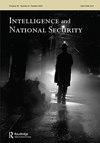印度的情报文化和战略惊喜:为南方集团从事间谍活动
IF 0.8
3区 社会学
Q1 HISTORY
引用次数: 0
摘要
Dheeraj Paramesha Chaya通过查阅档案、作者对印度高级情报官员的采访和二手资料,审视了印度的情报文化。在探讨印度情报失误和战略惊喜的具体案例时,他认为情报文化是理解“情报惊喜动态”的关键因素。Chaya进一步指出,“西方关于情报表现和战略惊喜的理论”在应用于印度时存在局限性(第4页)。印度外交情报机构研究与分析部前负责人Vikram Sood在2000年至2003年的前言中指出,称赞这本书,称其为“可能是第一本关于印度外国情报文化的学术著作”,并“通过档案信息和精英访谈澄清了事实”(p.x)。事实上,这本书深入了解了印度情报,涵盖了近2000年的历史,其中包括对印度情报人物的深入采访(附录中列出了被点名的受访者)。本书分为四个主题部分,共九章,不包括引言和结语。第一部分探讨了印度智力的理论方面、定义和文献综述,指出对印度智力的文化分析如何洞察智力的成功和失败。Chaya解释道,“有必要了解管理一个国家安全过程的哲学和思维过程,以理想地定位和理解其情报机构所扮演的角色”(第25页)。第二节探讨了从共同时代(BCE)之前的第二和第三世纪到后殖民地印度情报开始的情报演变。从考蒂尔亚(公元前375–283年)和他的古代治国论《阿尔塔沙斯特拉》开始,查亚解释说,知识对国家生存至关重要,“知识文化”是考蒂尔亚国家的基础。谈到1947年前英国在印度的殖民情报,他认为,考蒂尔扬思想一直是“治国方略的基础,直到殖民统治出现”,而殖民统治由于“殖民国家的要求”而消失,殖民国家的“反应性情报文化”更多地关注内部而非外部(第64页)。查亚描述了1947年独立后,殖民情报文化是如何持续的,其特点是主要应对威胁,并由情报管理人员制定,与考蒂尔扬州的“自上而下”方法形成鲜明对比。第三部分考察了1962年中印战争、1971年印巴战争和1999年卡吉尔战争。查亚首先分析了1962年中国未被发现渗透印度的背景和失败,得出结论本文章由计算机程序翻译,如有差异,请以英文原文为准。
India’s intelligence culture and strategic surprises: spying for South block
Dheeraj Paramesha Chaya examines India’s intelligence culture by drawing from archives, author interviews with senior Indian intelligence officers and secondary sources. Exploring specific cases of Indian intelligence failures and strategic surprises, he argues that intelligence culture is the key factor to understanding ‘intelligence-surprise dynamics’. Chaya further argues, ‘Western theories of intelligence performances and strategic surprises’ have limitations when applied to India (p.4). A foreword by Vikram Sood, former head of India’s foreign intelligence service Research and Analysis Wing from 2000 to 2003, praises the book by describing it as ‘perhaps the first academic work on India’s foreign intelligence culture’ and ‘sets the record straight with archival information and elite interviews’ (p.x). Indeed, the book provides insight into Indian intelligence, covering nearly 2,000 years, and includes insightful interviews with Indian intelligence figures (the named interviewees are listed in the appendix). The book is organized into four topical sections consisting of nine chapters, not including the introduction and epilogue. The first part explores theoretical aspects of Indian intelligence, definitions and a literature review, noting how a cultural analysis of Indian intelligence provides insight into intelligence successes and failures. Chaya explains, ‘It is necessary to understand the philosophies and thought processes governing a nation’s security processes to ideally locate and understand the role played by its intelligence agencies’ (p.25). The second section explores the evolution of intelligence from the second and third centuries before common era (BCE) until the start of post-colonial Indian intelligence. Beginning with Kautilya (375–283 BCE) and his ancient statecraft treatise the Arthashastra, Chaya explains knowledge was vital for state survival and ‘knowledge culture’ was the basis of the Kautilyan state. Turning to British colonial intelligence in India before 1947, he argues that Kautilyan thought remained ‘the basis for statecraft until the advent of the colonial rule’ which disappeared due to the ‘requirements of the colonial state’ that had a ‘reactive intelligence culture’ focused more internally than externally (p.64). Chaya describes how after independence in 1947 the colonial intelligence culture continued, which was marked by mainly responding to threats and shaped by the intelligence managers in contrast to the Kautilyan state’s ‘top-down’ approach. Moving to more recent events, the third part examines the 1962 Sino-Indian War, the 1971 IndoPak War and the 1999 Kargil War. First analysing the background and failures that led to China’s 1962 undetected infiltration of India, Chaya concludes
求助全文
通过发布文献求助,成功后即可免费获取论文全文。
去求助
来源期刊

Intelligence and National Security
Multiple-
CiteScore
1.80
自引率
41.70%
发文量
93
期刊介绍:
Intelligence has never played a more prominent role in international politics than it does now in the early years of the twenty-first century. National intelligence services are larger than ever, and they are more transparent in their activities in the policy making of democratic nations. Intelligence and National Security is widely regarded as the world''s leading scholarly journal focused on the role of intelligence and secretive agencies in international relations. It examines this aspect of national security from a variety of perspectives and academic disciplines, with insightful articles research and written by leading experts based around the globe. Among the topics covered in the journal are: • the historical development of intelligence agencies • representations of intelligence in popular culture • public understandings and expectations related to intelligence • intelligence and ethics • intelligence collection and analysis • covert action and counterintelligence • privacy and intelligence accountability • the outsourcing of intelligence operations • the role of politics in intelligence activities • international intelligence cooperation and burden-sharing • the relationships among intelligence agencies, military organizations, and civilian policy departments. Authors for Intelligence and National Security come from a range of disciplines, including international affairs, history, sociology, political science, law, anthropology, philosophy, medicine, statistics, psychology, bio-sciences, and mathematics. These perspectives are regularly augmented by research submitted from current and former intelligence practitioners in several different nations. Each issue features a rich menu of articles about the uses (and occasional misuses) of intelligence, supplemented from time to time with special forums on current intelligence issues and interviews with leading intelligence officials.
 求助内容:
求助内容: 应助结果提醒方式:
应助结果提醒方式:


